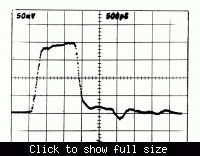05031208
Newbie level 3
avalanche transistor pulse generator
I want to generate a rectangular pulse with width adjustable from 1ns to 10ns.
It's fall time should be about 200ps.
The amplitude of the pulse is about 8v to 10v.
How can I make them ?
Thaks you all!
I want to generate a rectangular pulse with width adjustable from 1ns to 10ns.
It's fall time should be about 200ps.
The amplitude of the pulse is about 8v to 10v.
How can I make them ?
Thaks you all!
